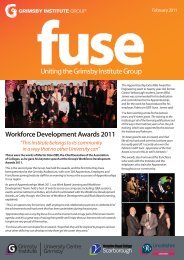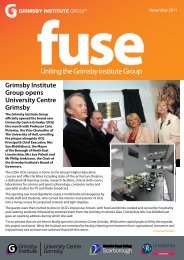Journal of Research & Scholarly Output 2006 - Grimsby Institute of ...
Journal of Research & Scholarly Output 2006 - Grimsby Institute of ...
Journal of Research & Scholarly Output 2006 - Grimsby Institute of ...
You also want an ePaper? Increase the reach of your titles
YUMPU automatically turns print PDFs into web optimized ePapers that Google loves.
<strong>of</strong> expansion. Its one-year higher national<br />
certificate and its two-year higher national<br />
diploma courses, available part-time and<br />
full-time, accounted for the great majority <strong>of</strong><br />
this higher education contribution. These<br />
programmes were <strong>of</strong>fered within a Scottish<br />
framework <strong>of</strong> vocational qualifications and,<br />
in the tradition <strong>of</strong> local authority further<br />
education, they were funded (and continued<br />
to be regarded) as ‘advanced’ further<br />
education. In this way, the colleges were<br />
able to assume major responsibility for a<br />
level and category <strong>of</strong> work that was <strong>of</strong>fered<br />
less and less by the central institutions.<br />
Moreover, support for this growth continued<br />
under the Scottish Office after 1992 when it<br />
took over funding responsibility for the<br />
colleges from the local authorities.<br />
establishments was just one factor<br />
sustaining the college contribution to higher<br />
education at these levels.<br />
This discrete mission for higher education in<br />
further education at the sub-degree levels is<br />
evident in the not inconsiderable amounts <strong>of</strong><br />
advanced work found in most colleges.<br />
Most <strong>of</strong> this provision is part-time,<br />
continuing a long and well-established<br />
pattern <strong>of</strong> students studying while in<br />
employment. Nevertheless, more recent<br />
growth has seen a new focus on full-time<br />
courses at the higher national levels. As a<br />
result <strong>of</strong> these twin trends, the majority <strong>of</strong><br />
new undergraduate level entrants to<br />
Scottish higher education now commence<br />
their studies in further education settings.<br />
When, in response to a looming financial<br />
crisis, full-time undergraduate expansion in<br />
all parts <strong>of</strong> the United Kingdom was brought<br />
to a halt in 1994, Scotland had more than a<br />
quarter <strong>of</strong> its higher education students in<br />
the further education sector. All the same,<br />
this was only a slight increase in the college<br />
proportion found at the start <strong>of</strong> the<br />
expansion era. What has been described as<br />
two parallel systems <strong>of</strong> higher education in<br />
Scotland (Gallacher, 2002) was not a<br />
product <strong>of</strong> the passage to mass higher<br />
education. Rather, it was a means by which<br />
that country was able to achieve a relatively<br />
smooth transition to mass conditions and,<br />
at the same time, maintain its lead (with<br />
Northern Ireland) in higher levels <strong>of</strong><br />
participation in the United Kingdom. That<br />
advanced further education courses were<br />
funded at a lower average level <strong>of</strong> resource<br />
than the early years <strong>of</strong> a four-year degree<br />
programme in Scottish higher education<br />
As in all regions <strong>of</strong> the United Kingdom, the<br />
opportunity to study in a locally accessible<br />
college is particularly important in providing<br />
a route back into education for adult<br />
students, both at the stage <strong>of</strong> initial entry to<br />
further education and then into higher level<br />
programmes. Scottish further education<br />
colleges do not just bring an older range <strong>of</strong><br />
students into undergraduate studies than<br />
other face-to-face establishments. There is<br />
evidence as well that, compared to the<br />
higher education sector, they have been<br />
successful in attracting a much higher<br />
percentage <strong>of</strong> students from disadvantaged<br />
areas (Raab, 1998). Participation rates in the<br />
colleges for those from the most<br />
disadvantaged areas were about twice as<br />
high as those in the higher education sector<br />
and, in the Scottish system at least, the<br />
further education colleges appeared to have<br />
a key role in widening access to higher<br />
education.<br />
FOCUS Page Page 11

















